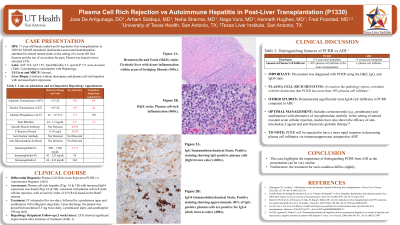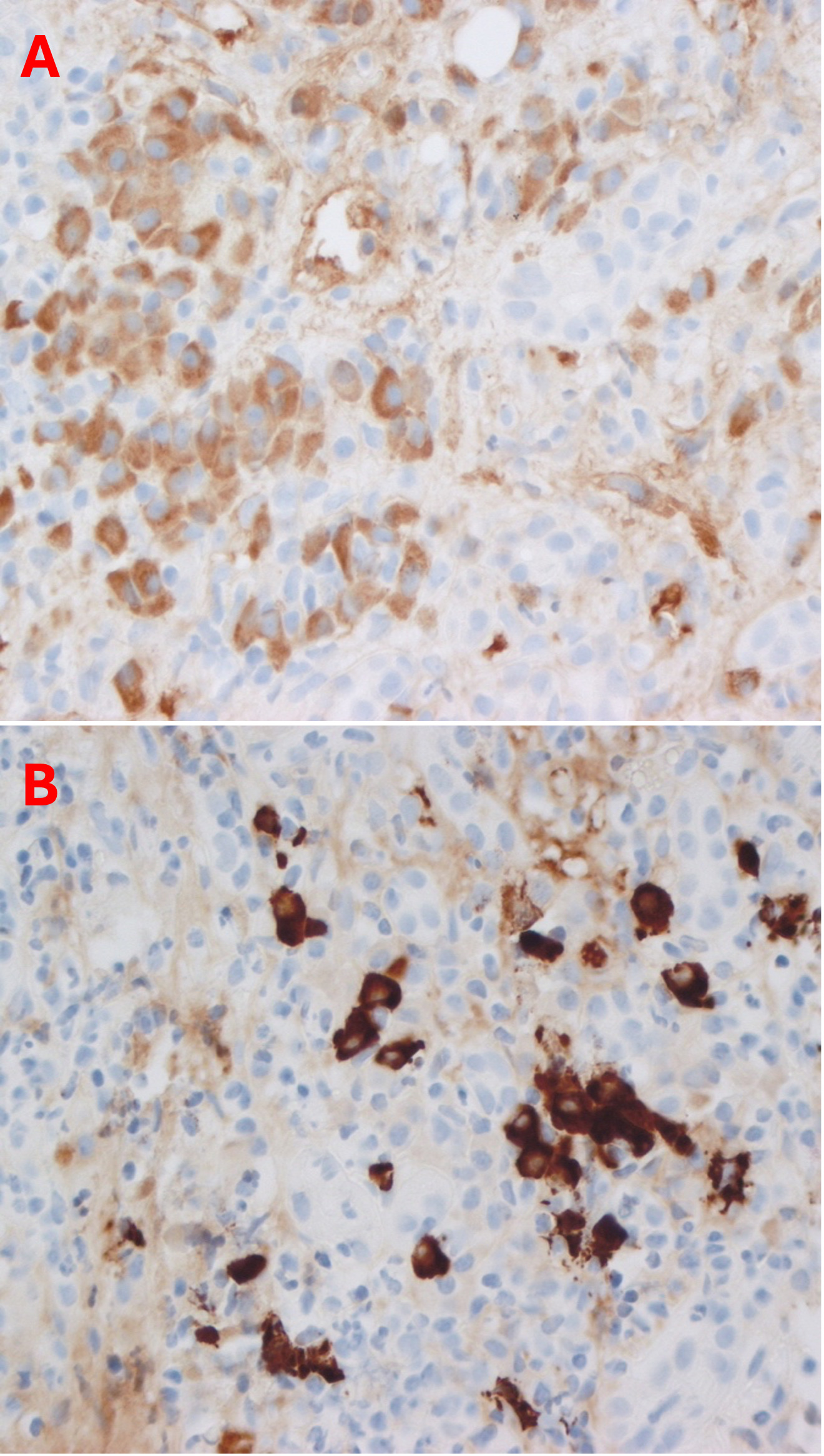Sunday Poster Session
Category: Liver
P1330 - Plasma Cell-Rich Acute Rejection vs Autoimmune Hepatitis in Post-Liver Transplantation
Sunday, October 27, 2024
3:30 PM - 7:00 PM ET
Location: Exhibit Hall E

Has Audio

Jose I. De Arrigunaga, DO
University of Texas Health San Antonio
San Antonio, TX
Presenting Author(s)
Jose I.. De Arrigunaga, DO1, Arham Siddiqui, MD1, Neha Sharma, MD2, Naga Vura, MD1, Kenneth Hughes, MD1, Fred Poordad, MD3
1University of Texas Health San Antonio, San Antonio, TX; 2University of Texas Health Science Center, San Antonio, TX; 3UTHSCSA, Texas Liver Institute, San Antonio, TX
Introduction: Plasma cell-rich acute rejection (PCRR) in liver transplantation, a poorly understood cause of late acute rejection, is an uncommon occurrence, happening in only 3-5% of recipients. PCRR is frequently misdiagnosed as autoimmune hepatitis (AIH) due to similar histological findings including interface hepatitis, high titers of autoantibodies, and hypergammaglobulinemia. However, specific features of PCRR can help differentiate it from AIH. We present to you a case of PCRR in an elderly female and our journey to accurately diagnose PCRR.
Case Description/Methods: A 71-year-old female underwent living-donor liver transplantation in 2020 for nonalcoholic steatosis (NASH). She was admitted for altered mental status in the setting of a recent left foot fracture and the use of oxycodone for pain. Elevated liver function tests (LFTs) were noted (aspartate transaminase (AST) 310, alanine transaminase (ALT) 155, total bilirubin 2.5, alkaline phosphatase (ALP) 171). Smooth muscle antibody and Immunoglobin G were positive at 49.94 and 2,171, respectively. Ultrasound of the liver transplant and Magnetic Resonance Cholangiopancreatography (MRCP) yielded negative results. A liver biopsy later revealed cirrhosis without ductopenia. Furthermore, plasma cell-rich hepatitis with increased IgG4 expression was found (Figure 1), consistent with plasma cell-rich acute cellular rejection. Treatment commenced with steroids and azathioprine. A follow-up with Hepatology outpatient occurred two weeks later with improvement of LFTs.
Discussion: Plasma cell infiltration can be found in both PCRR and AIH. One study showed that there are a few distinguishing features between PCRR and AIH. First, PCRR usually manifests 2-5 years post-transplant, while AIH typically occurs after five years post-transplant. Second, PCRR exhibits two unique antibodies that AIH lacks: glutathione S‐transferase theta 1 (GSTT1) and donor-specific human leukocyte antigen antibodies (DSAs). Finally, as in this case, PCRR can be set apart from AIH by the amount of plasma cell infiltrate (PCRR: > 30% plasma cell infiltrate in the total cell population) and with the help of IgG4 immunostaining. One study demonstrated significantly more IgG4-rich infiltrates in PCRR compared to AIH. Therefore, plasma cell-rich hepatitis, as read on the pathology report, correlates with the distinction that PCRR has more than 30% plasma cell infiltrate. This case highlights the importance of distinguishing PCRR from AIH as the presentation can be very similar.

Disclosures:
Jose I.. De Arrigunaga, DO1, Arham Siddiqui, MD1, Neha Sharma, MD2, Naga Vura, MD1, Kenneth Hughes, MD1, Fred Poordad, MD3. P1330 - Plasma Cell-Rich Acute Rejection vs Autoimmune Hepatitis in Post-Liver Transplantation, ACG 2024 Annual Scientific Meeting Abstracts. Philadelphia, PA: American College of Gastroenterology.
1University of Texas Health San Antonio, San Antonio, TX; 2University of Texas Health Science Center, San Antonio, TX; 3UTHSCSA, Texas Liver Institute, San Antonio, TX
Introduction: Plasma cell-rich acute rejection (PCRR) in liver transplantation, a poorly understood cause of late acute rejection, is an uncommon occurrence, happening in only 3-5% of recipients. PCRR is frequently misdiagnosed as autoimmune hepatitis (AIH) due to similar histological findings including interface hepatitis, high titers of autoantibodies, and hypergammaglobulinemia. However, specific features of PCRR can help differentiate it from AIH. We present to you a case of PCRR in an elderly female and our journey to accurately diagnose PCRR.
Case Description/Methods: A 71-year-old female underwent living-donor liver transplantation in 2020 for nonalcoholic steatosis (NASH). She was admitted for altered mental status in the setting of a recent left foot fracture and the use of oxycodone for pain. Elevated liver function tests (LFTs) were noted (aspartate transaminase (AST) 310, alanine transaminase (ALT) 155, total bilirubin 2.5, alkaline phosphatase (ALP) 171). Smooth muscle antibody and Immunoglobin G were positive at 49.94 and 2,171, respectively. Ultrasound of the liver transplant and Magnetic Resonance Cholangiopancreatography (MRCP) yielded negative results. A liver biopsy later revealed cirrhosis without ductopenia. Furthermore, plasma cell-rich hepatitis with increased IgG4 expression was found (Figure 1), consistent with plasma cell-rich acute cellular rejection. Treatment commenced with steroids and azathioprine. A follow-up with Hepatology outpatient occurred two weeks later with improvement of LFTs.
Discussion: Plasma cell infiltration can be found in both PCRR and AIH. One study showed that there are a few distinguishing features between PCRR and AIH. First, PCRR usually manifests 2-5 years post-transplant, while AIH typically occurs after five years post-transplant. Second, PCRR exhibits two unique antibodies that AIH lacks: glutathione S‐transferase theta 1 (GSTT1) and donor-specific human leukocyte antigen antibodies (DSAs). Finally, as in this case, PCRR can be set apart from AIH by the amount of plasma cell infiltrate (PCRR: > 30% plasma cell infiltrate in the total cell population) and with the help of IgG4 immunostaining. One study demonstrated significantly more IgG4-rich infiltrates in PCRR compared to AIH. Therefore, plasma cell-rich hepatitis, as read on the pathology report, correlates with the distinction that PCRR has more than 30% plasma cell infiltrate. This case highlights the importance of distinguishing PCRR from AIH as the presentation can be very similar.

Figure: Figure 1A: 400X magnification IgG Immunohistochemical Stain: positive staining showing IgG-positive plasma cells (light brown color).
Figure 1B: 400X magnification IgG4 Immunohistochemical Stain: positive staining showing approximately 40% of IgG-positive plasma cells are positive for IgG4 (dark brown color).
Figure 1B: 400X magnification IgG4 Immunohistochemical Stain: positive staining showing approximately 40% of IgG-positive plasma cells are positive for IgG4 (dark brown color).
Disclosures:
Jose De Arrigunaga indicated no relevant financial relationships.
Arham Siddiqui indicated no relevant financial relationships.
Neha Sharma indicated no relevant financial relationships.
Naga Vura indicated no relevant financial relationships.
Kenneth Hughes indicated no relevant financial relationships.
Fred Poordad indicated no relevant financial relationships.
Jose I.. De Arrigunaga, DO1, Arham Siddiqui, MD1, Neha Sharma, MD2, Naga Vura, MD1, Kenneth Hughes, MD1, Fred Poordad, MD3. P1330 - Plasma Cell-Rich Acute Rejection vs Autoimmune Hepatitis in Post-Liver Transplantation, ACG 2024 Annual Scientific Meeting Abstracts. Philadelphia, PA: American College of Gastroenterology.
